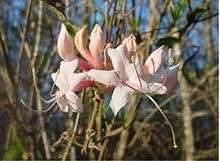Rhododendron atlanticum
| Rhododendron atlanticum | |
|---|---|
 | |
| Rhododendron atlanticum at Stuckey, South Carolina | |
| Scientific classification | |
| Kingdom: | Plantae |
| (unranked): | Angiosperms |
| (unranked): | Eudicots |
| (unranked): | Asterids |
| Order: | Ericales |
| Family: | Ericaceae |
| Genus: | Rhododendron |
| Subgenus: | Pentanthera |
| Section: | Pentanthera |
| Species: | R. atlanticum |
| Binomial name | |
| Rhododendron atlanticum Rehder | |
Rhododendron atlanticum (Greek Ροδόδενδρο) (dwarf azalea[1] or coastal azalea), is a species of Rhododendron native to coastal areas of the eastern United States, from New Jersey south to Georgia.
It is a deciduous shrub 50–150 cm tall, forming a thick understory in forests, spreading by underground stolons. The leaves are 3–5 cm long and 1–2 cm broad, bluish green, and hairless or with scattered glandular hairs. The fragrant flowers are 3–4 cm long, usually white to pink, sometimes with a bit of yellow; they are produced in trusses of 4-10 together.
Cultivation and uses
It is not widely cultivated in North America, but has been introduced and is popular in England. In the U.S. it is regarded as a good plant for heavy soils, but will spread itself too freely if planted in sandy soils.
References
- ↑ "Rhododendron atlanticum". Natural Resources Conservation Service PLANTS Database. USDA. Retrieved 21 October 2015.